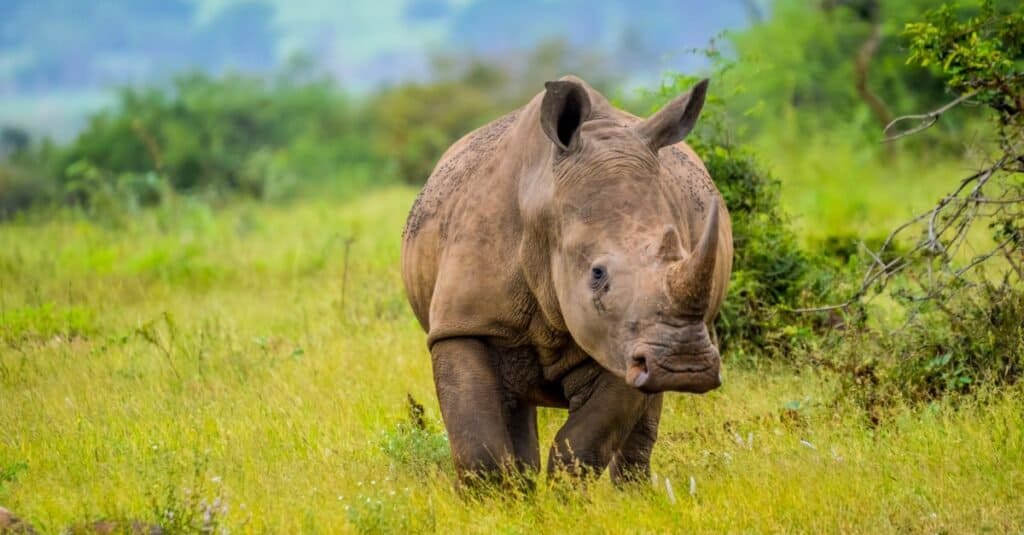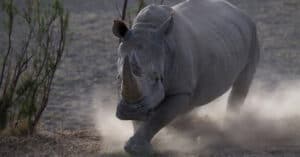If you’ve ever approached a white rhino in the wild, you’ll know how downright intimidating they can be. Their massive bodies, thick heads, and formidable horns all testify to their majestic power. Given how many northern white rhinos and southern white rhinos are left in the world, however, the future of these mighty beasts is not guaranteed. Read on to discover everything from the biggest white rhino ever recorded to why their horns are considered so valuable.

There are about 18,000 white rhinos left in the world. All but 2 of these individuals belong to the southern white rhino subspecies.
©iStock.com/Shams
What is a White Rhino?
White rhinos are a species belonging to the rhinoceros family, Rhinocerotidae. Their scientific name is Ceratotherium simum. In Greek, this references both the rhinos’ horns and flat noses.
Despite being “white rhinos,” these animals are actually gray in colour. This is due to a simple misunderstanding. Dutch settlers called these rhinos “weit,” meaning “wide” in Afrikaans, but English settlers misheard it as “white.” Although incorrect, the name stuck.
There are 5 different species of rhino in the world today: the white rhino, black rhino, Indian rhino, Javan rhino, and Sumatran rhino. The white and black rhinos reside in Africa while the Indian, Javan, and Sumatran rhinos exist in Asia.
How Many White Rhinos Are Left in the World?
There are approximately 16,000 white rhinos left in the world. Although this number is not as high as conservationists would like, it’s a vast improvement over what it used to be.
There are 2 subspecies of white rhino: the northern white rhino and the southern white rhino.
Northern White Rhino
There are only two known individual northern white rhinos left in the world, and they are both female. This means they are functionally extinct. Their names are Najin and Fatu. The last male died in 2018 of health complications. Unfortunately, both females would be unable to produce offspring even if there was a viable male still living. They are guarded day and night on the Ol Pejeta Conservancy in Kenya.
This northern subspecies is smaller than its southern brethren including its horns, head, and the hump on its back.
Southern White Rhino
The southern white rhino exists in only 4 African countries: South Africa, Namibia, Zimbabwe, and Kenya. Almost every rhinoceros in Africa belongs to the southern subspecies.
Before 1895, southern white rhinos were thought to be extinct. Then a group of about 100 was discovered in South Africa. From that group, conservationists carefully grew the population to what it is today.

White Rhino Appearance and Speed
White rhinos are the largest rhino species in existence. They are also the second-largest land animal next to the African bush elephant. They can weigh as much as 3,600 kg, almost 8,000 pounds! Adult males can grow up to 4 metres in length and 1.9 metres in height. Their heads are so massive that they require a hump of muscle on their shoulders to give it support. They sport two horns, one large and one small, and sizeable ears. Their mouths are broad and square, unlike the triangular mouths of black rhinos.
You might not think it from their size, but white rhinos are surprisingly fast. At top speed, they clock in at over 30 miles per hour. Unfortunately, they can be aggressive when defending their territory, and their quick acceleration means their targets may not get out of the way in time. With exceptionally tough skin, they are nearly immune to cuts and other injuries.
White Rhino Diet
Despite their frightening demeanour, white rhinos are herbivores. They graze the open savannas of Africa, eating more than 120 pounds of grass each day. Because of their square mouths, they can’t eat from trees or bushes like the black rhino.
White Rhino Predators and Lifespan
Can something as large as a rhino have predators? The answer depends on the age of the rhino. Though its predators are few, white rhino adolescents must keep an eye out for big cats like lions and cheetahs. They also face threats from crocodiles, hyenas, and wild dogs. Once they reach adult size, they will rarely, if ever, be bothered. Humans, their biggest predator, are the exception to this rule.
White rhinos can live 40-55 years in the wild. They have a long gestation period of up to 500 days, after which they typically don’t give birth for another 3-4 years. This makes repopulation difficult.
The Biggest White Rhino in the World
The biggest white rhino ever recorded weighed about 4,500 kg, or almost 10,000 pounds! The largest white rhino horn on record measured 150 centimetres (59 inches). White rhinos’ horns grow larger than those of any other species of rhino.
Are White Rhinos Dangerous?
White rhinos are generally placid when not threatened, more so than black rhinos. However, males can be extremely territorial, charging anything they perceive to be dangerous. Their hearing and sense of smell are both keen, but they have notoriously poor eyesight. This sometimes leads them to charge animals or objects that don’t pose a threat.
Mothers with calves are just as dangerous, if not more. These females will charge if they believe their offspring are in danger. Contrary to popular belief, rhinos use their lower incisors to inflict damage more than they use their horns.

The IUCN lists white rhinos as Near Threatened. The northern white rhino subspecies, however, is functionally extinct.
Are White Rhinos Endangered?
The International Union for Conservation of Nature lists white rhinos as Near Threatened. This refers to the species in general and not to the northern subspecies, which is functionally extinct.
White rhinos have battled extinction for well over a hundred years due to poaching. Their horns are highly valuable for traditional Chinese medicine and as coveted trophies, which is why there are only two northern white rhinos left in the world.
An elaborate attempt to save the northern white rhino is underway. Scientists, led by Dr. Cesare Galli in Italy, are attempting to fertilize white rhino eggs from the remaining white rhinos Najin and Fatu. For years scientists collected sperm from the only remaining male white rhinos, including Suni and Sudan, the last 2 to die. The process of collecting both sperm and eggs is highly fraught, but with extreme care, both have been secured.
The idea is to create baby white rhinos using in vitro fertilization (IVF). However, even if this is successful, the embryos need a surrogate. Neither Najin nor Fatu are suitable for the purpose. Therefore, scientists are looking to southern white rhino females for surrogates. Theoretically, through medical manipulation, white rhino calves could be born in the next few years.
This is not a given, however. The process is notoriously complicated and uncertain. Added to that, some conservationists believe that humans should allow northern white rhinos to go extinct. They reason that the vast sums of money needed to artificially keep the subspecies alive could be used to much better effect on other rhino species. Additionally, they worry that with such a small genetic pool, northern white rhinos will not be healthy or diverse enough to survive on their own.
Although white rhinos are not in the clear yet, it’s heartening to know that their chances of survival are better than they have been for the past hundred years.
Up Next:
- Are Rhinos Extinct: The Conservation Status of Every Rhino Species
- What Are Rhino Horns Made Of? And Everything Else You Wanted To Know About Rhino Horns
The photo featured at the top of this post is © EcoPrint/Shutterstock.com
Thank you for reading! Have some feedback for us? Contact the AZ Animals editorial team.






